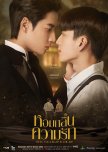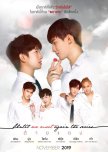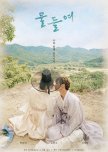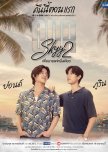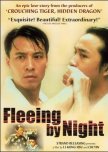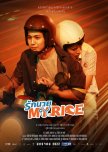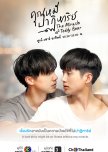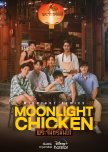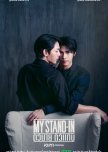BL Series with Historical Settings
The modern gay and lesbian identity thrives across the globe today. In much of the western world, laws now protect the equality of gay and lesbian individuals. Each year, marriage equality gains traction in more countries. Even people who live in places that reject queer equality have an awareness that things are better elsewhere, that they are not alone. Curiously, the English word “gay” has emerged as a marker of queer identity, even in countries where English is not the primary language. That term did not itself gain common currency within the community until the middle decades of the prior century. The jet age, the television age, and, later, the rise of the internet, all helped it proliferate across the globe. Everywhere it spread, it carried its baggage: the idea of gay pride, the idea “we are born this way,” the idea that the law should treat us equally.
Pride and equality are a recent notion. A half-century ago, most languages had their own word for same sex attraction and sexual contact. Each of those terms carried their own baggage. While consequences and concepts varied, condemnation was common. The emergence of a “gay" identity therefore represents a transition toward a global queer model based on pride that replaced a litany of local identities and concepts almost all of which marginalized the people defined by that concept.
Because the typical BL series aspires to depict happy, healthy same-sex relationships, an overwhelming majority of them are set in recent times. A few BL series set themselves in the more distant past. Such settings should avoid the pride model of queer identity. Instead, they ought to depict whatever terminologies prevailed in the country’s past. In some cases, those models may be unrecognizable to foreign audiences and seem outdated to domestic viewers. This list evaluates how well BL series set in the past have depicted the reality of same-sex attraction in that time and place.
-
1. To Sir, with Love
Thai Drama - 2022, 17 episodes
This 2022 Thai series is set in the 1940s. World War II marks the moment in the west when the word “homosexual” began to gain currency as the dominant model of explaining same-sex attraction. It entered the vernacular as a medical term and was previously known primarily to specialists in medicine or law. “Homosexual” conveys the idea that a person has a sickness, something in need of curing or fixing. This sickness model replaced the prior sin model, which defined the queer person as an immoral sinner. (“There’s nothing wrong with us” rejects the assumptions of both the sickness and sin models.) During the period the sickness model prevailed, many gay people believed there was something wrong with them. Shades of both the sin and sickness model influence the depiction of the three gay characters in To Sir, With Love.
A full-fledged lakorn, rather than a BL, the series mostly gets right how gay men in the 1940s would have been treated. Tian, the lead character, regards his sexuality as a source of shame, something to be hidden away and repressed. His family echoes this sentiment. Much of the (melo)dramatic action in the series arises from efforts to maintain Tian’s closet. The first episode, set during Tian’s childhood, includes a scene where a business associate’s homosexuality is revealed, sowing confusion among those who’ve never previously heard this new-fangled term. That lack of awareness rings true, as does the public shaming that leads to the character’s suicide, an event that shaded young Tian’s understanding of his future prospects. When he eventually encounters a working-class love interest, neither inintially believes they can dream of a future together. A product of our times, the series ultimately permits Tian a happy ending—one that reflects the pride model in its wish that “people like me get treated like everyone else” and that Tian should be judged according to his personal qualities.
-
2. Smells Like Green Spirit
Japanese Drama - 2024, 8 episodes
-
3. I Feel You Linger in the Air: Uncut Version
Thai Drama - 2023, 12 episodes
This 2023 Thai series is set primarily in 1928 Chiang Mai, although it opens and closes in the present day. In 2023, Jom has been hired to renovate an old mansion. During an eventful first episode, his car crashes into the river. Jom wades ashore and abruptly realizes he has waded into the year 1928.
The series never volunteers any explanation for Jom’s time traveling. Is he supposed to fix the past? His own present? Why did he return to 2023? Viewers should simply enjoy the series as a period piece. The costuming is excellent, and anytime Jom commits a social faux pas, some other character will offer a helpful primer on the proper etiquette of the day. Aside from an early adventure in a local market and rather ostentatious visits to a social club catering to wealthy folks whose private lives benefit from “discretion,” most of our window into 1928 unfolds on the estate of a wealthy family. In fact, their ancestral home is the selfsame mansion Jom has been renovating a century later.
Jom soon recognizes the family’s eldest son from his dreams. And Yai, in turn, recognizes Jom from his own. Drawn to one another, Yai hires Jom to function as his body servant, making Linger a unique twist on both the master-servant and the employer-employee tropes. Fitting for 1928, Yai is utterly oblivious to the power dynamics inherent to such romances, as power differentials have defined his entire life. (Fish don’t notice water, eh?) Yai’s sister is involved romantically with her maid. The series escapes potential anachronism by simply never naming the love that dared not speak its name. Whatever these four and the "discreet" men in the club thought of themselves, the script never labels it. The club has some historical precedent in the west, even in the era when “sin” and “sickness” remained prevalent in the self-conception of the gay imagination.
-
4. Until We Meet Again
Thai Drama - 2019, 17 episodes
This 2019 Thai series divides its timeline between 2019 and an unspecified point in the 1980s. A same-sex couple dominates the story in both timelines. The contemporary couple’s fledgling romance is supported and encouraged by an array of both friends and family. No one in the 2019 storyline is remotely bothered that these two men have embarked upon a relationship with one another. By contrast, the other couple’s story ends differently. As that story “ends” in the first scene of the first episode, I spoil nothing by revealing that the pair commit suicide. UWMA’s pilot episode stands as perhaps the most shocking premiere episode yet for any BL series. It’s clear from that stunning opening sequence that family opposition to their romance drove the two high school students to this tragic decision. Flashbacks across the remainder of the series illustrate the circumstances in which the ill-fated lovers met, fell in love, and, ultimately, died together. What should be clear is that their experience differs markedly from the contemporary couple.
UWMA is unique on this list in a number of respects. It is the highest-rated, most viewed and best loved series in the list. It is the only list entry where the “historical” romance qualifies as a side couple rather than the lead couple. Its “historical” setting is the most recent period on the list. I include it to illustrate just how quickly the pride model influenced social attitudes. Still gaining prevalence in the west in the 1980s, the pride model exerted little influence over Thai attitudes toward sexuality in the 1980s. In the space of a single generation, attitudes changed. Indeed, family members of Korn and Intouch survived to appear in the 2019 storyline as well. Change occurred within living memory. For these reasons, UWMA offers perhaps the clearest example of explaining the usefulness of the models as a means to explain how society treated gay people at different times.
-
5. Killer and Healer
Chinese Drama - 2021, 37 episodes
This 2021 series from China is only nominally a BL. As usual for series produced in the People’s Republic, government censorship constrained the creative options at depicting the relationship between the titular killer and healer: one, a policeman; the other, a doctor. Gazing longingly into one another’s eyes substitutes for kissing or proper romancing. Set in the 1930s, a period of civil war prior to the advent of the current government. Despite its dubious qualities as a BL, the series is an outstanding period piece. Rich production values are evident in the lavish wardrobe adorning scores of extras; the abundance of period automobiles, the many outside street scenes, and large set piece gun battles. Like To Sir With Love, the characters in Killer and Healer cannot quite grasp a set of circumstances in which they would be allowed to live together in an unfettered way. There is no hint of an overt “gay culture” to provide a framework for their lives or to suggest they are not alone. Despite these limitations, it’s clear the writers want viewers to regard the pair as a couple. Similar tactics undermine the queer storytelling for Chinese BL series set in contemporary times. Here, however, the censorship of gay themes actually infuses Killer and Healer with increased historical verisimilitude. Comparing the series to BL fare produced in other countries in 2021, provides a glaring reminder that not every country in the world treats gay men and lesbians equally as a matter of law. The pride model has not yet asserted itself universally.
-
6. Nobleman Ryu's Wedding
Korean Drama - 2021, 8 episodes
This 2021 Korean series is set in the country’s Joseon period, a point prior to western or Japanese imperialism, sometime in the 17th to 19th centuries. I believe it became the first BL to attempt to depict a same-sex romance in the more distant past. Unfortunately, the series never quite succeeds to deliver a BL story or, frankly, a compelling one. When his sister humiliates the family by absconding ahead of her wedding, Choi Ki Wan attempts to save the family honor by impersonating her. He dons her garb and marries Nobleman Ryu in her stead. The unsuspecting Ryu quickly falls for Choi. Eventually, the fraud cannot be maintained, but Ryu conspires with the Choi family to maintain the illusion until his "true" wife reappears. During that time, Choi and Ryu develop an affinity for one another. Perhaps aware that the Joseon era offered no viable avenue for two men to pursue one another, the series mostly shies away from implying the two comprise a gay couple. Ryu eventually realizes his attraction is for Ki Wan, but that attraction stems from their respective personalities, not necessarily a preference for an entire sex. (A fresh variant on the BL-saw, "I'm not gay, I just like you.") The series does manage to find the one plausible path two noblemen could pursue to live together: a scholarly life out of sight in the countryside.
-
7. Tinted with You
Korean Drama - 2021, 8 episodes
This late 2021 series makes least use of its historical setting as any series on this list. It opens in the present-day when high school student Eun Ho visits an art gallery. While there, an old landscape painting fascinates him. Soon, a mysterious stranger imparts some odd advice, and shortly thereafter he finds himself transported to the Joseon period. Once there, he encounters Crown Prince Lee Heon and his bodyguard. The two of them suspect Eun Ho is an assassin dispatched by the King to eliminate Lee Heon. They quickly discard that notion when they realize the stranger has no idea how to function in their society.
The series wastes the chance to compare modern attitudes toward sexuality with historical antecedents. Eun Ho never asserts a modern gay sexuality, and Lee Heon never defines romance as a personal goal. A friendship between Eun Ho and Lee Heon soon sprouts, though whether that friendship reflects romantic attraction, sexual attraction, or mutual fascination with the other’s foreignness is never made clear. On an outing together, Eun Ho discovers the prince has a flair for painting. Moreover, he realizes the landscape in the art gallery had just been painted before his eyes. Perhaps he’d been sent into the past to help produce the painting? Sure enough, Eun Ho is returned to the present, and manages to bring the Crown Prince forward with him. Again, the series wastes its chance to explore different notions of sexuality as the series simply comes to an end.
-
8. Our Skyy 2: Never Let Me Go
Thai Special - 2023, 2 episodes
The 2022-23 series Never Let Me Go contained no time travel elements whatsoever, but when the two lead characters reappear for two episodes in the 2023 anthology Our Skyy 2, they find their consciousness sent back to an unspecified moment in the Thai past. Their "mission" is to break a pattern where their past selves fall in love only for circumstances to thwart their romance. That the past is inhospitable to the mere possibility of same-sex romance is only one of the difficulties they encounter. Phuwin and Pond have an easy chemistry with one another that makes the two episodes a fun watch. But none of these anthology series exist to tell meaty stories. Still, for reminding us that people in the past constructed sexual possibilities differently than we do today, it's worth tacking a mention of these two episodes to the back of this list.
Note: The teaser trailer for I Feel You Linger in the Air had been released prior to the production of these special episodes. One suspects the specials borrowed plot elements from the source novel to establish a story line for the specials.
-
9. Fleeing By Night
Taiwanese Movie - 2000
HONORABLE MENTION—This film from 2000 is neither BL nor a TV series and therefore does not quite fit the spirit of this list. While a tiny fraction is set in present-day New York, most of the action is set in mainland China during the Republic period and, later, during the period when the Communist Party sought to consolidate its notion of law, politics, and morality on the newly established People's Republic. The Communists branded homosexual behavior as an example of dissolute morality that exemplified the breakdown of proper society under capitalism. Hence, a clear contrast exists between the options available to the two leads to pursue romance when they first met (Republic era) and when they meet again following the Civil War (People's Republic era). In neither period, did a proper "vocabulary" exist for them to label their attraction. Society simply did not recognize same-sex attraction as a viable option.
That very inability to label their feelings demonstrates why the pride model eventually caught on within the queer community. Unlike the sickness and sin models—local Chinese vestiges of which are apparent here—the pride model is the only in which queer people insist on defining themselves. Fleeing by Night is an excellent evocation of a complicated moment in Chinese history as well as an emotionally rewarding depiction of two men who loved one another despite familial and societal opposition.



